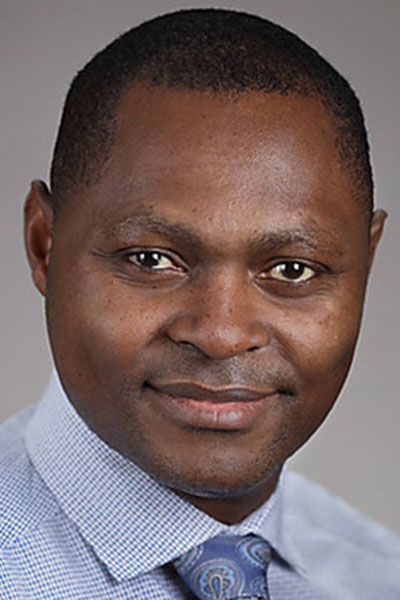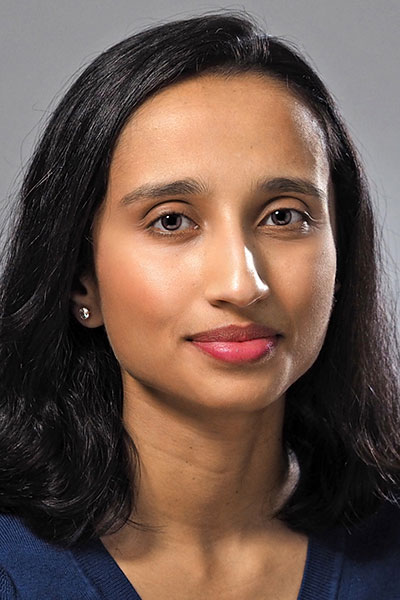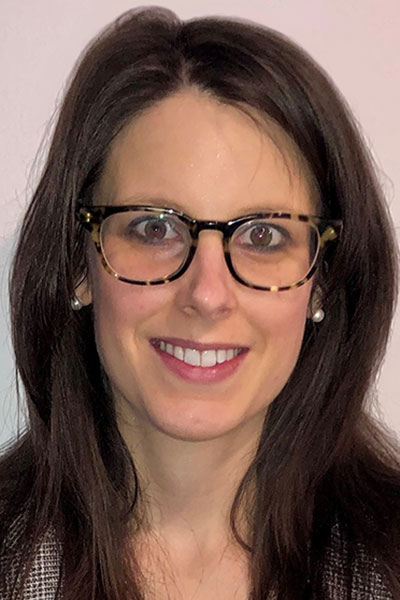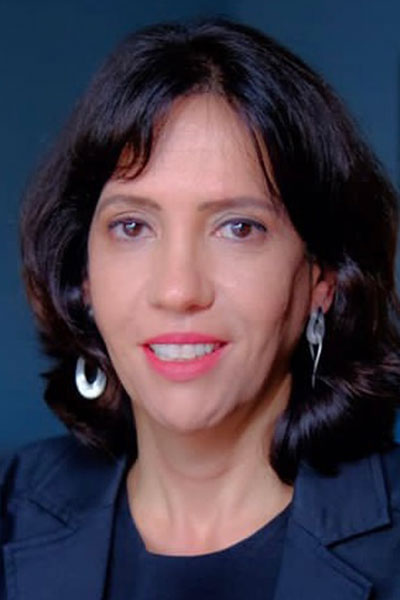The annual Clinical Year in Review will conclude on Wednesday, May 24, with experts highlighting the most impactful papers in lung transplant, medical education, health disparities, and cystic fibrosis/non-CF bronchiectasis. Clinical Year in Review 4 will take place from 8–9:30 a.m. ET in Hall E (Level 2) of the Walter E. Washington Convention Center.

Survival rates following lung transplant have remained dismal for decades—the worst for any solid organ transplant, said Sean Agbor, MD, PhD, Lasker Clinical Research Scholar in applied precision omics, National Heart, Lung, and Blood Institute. He will review the most recent literature on lung transplant, including an explanation of how the Composite Allocation Score replaced the Lung Allocation Score system for identifying and prioritizing recipients for organ transplantation earlier this year and the potential created by the cell-free DNA test for head-to-head comparisons with the effectiveness of bronchoscopy.
“What I will be presenting is what I would consider true innovation that is opening the door for new opportunities to improve the donor lung survival within that recipient,” Dr. Agbor said. “We have discovered that we can now modify the donor organ in the recipient’s favor, and we can better monitor patients for transplant rejection using a simple blood test instead of an invasive biopsy.”
After lung transplantation, the donor lung gets “attacked” by the recipient or patient immunity to cause rejection. The proof-of-concept works suggest that one could alter components of the transplanted lung that contribute to rejection, including the type of bacteria or immune cell composition. Follow-up studies should test whether changing these components reduces the risk of rejection. This is a potential game-changer for these unfortunate patients who develop rejection at a high rate.
Another study addresses rejection by proposing the routine use of a blood test that can detect rejection early. Bronchoscopy plus biopsy is routinely used to look for infection and rejection of a donor organ. Despite its prevalence, this method has limited effectiveness because it has low sensitivity and often misses rejection until the late stages, Dr. Agbor said.
The new cell-free DNA test looks for the DNA coming from a transplanted organ.
“These tests have been shown to pick up rejection better and earlier than biopsy; however, the new advancement from this year is that for the first time, a study uses this test in monitoring patients instead of bronchoscopy.”

Deepshikha Ashana, MD, MBA, MS, will discuss papers on health equity, the volume of which has increased substantially in the past few years. Race correction in spirometry and global medical oxygen security are two hot topics in pulmonary medicine right now.
“Spirometry is how we measure lung function, and the standard for a long time has been to adjust the values based on a person’s race. This is problematic because it reinforces a false narrative that race is a biological risk factor for health,” said Dr. Ashana, assistant professor of medicine, Duke University. “Recently, in medicine as a whole, there’s been a strong examination of and backlash against race-based medicine. The reality is that race is not a biological risk factor; it’s not a proxy for ancestry or genetic risk. It’s really a social classification that’s imposed upon people.”
Dr. Ashana will review two studies that compared race-specific and race-neutral reference equations for spirometry. Both concluded that incorporating race does not improve the prediction of clinically meaningful outcomes.
She also will highlight literature on pulmonary health policy evaluation, gender bias in clinical decision-making, and the inadequate access to medical oxygen that exists internationally.
A recent mixed-methods study of 350 health facilities in four countries outside of the U.S. aimed to identify available resources at those facilities to treat severe pediatric pneumonia.
“The really surprising thing for U.S.-based clinicians might be that only 13 percent of these facilities were judged to be adequately resourced to manage severe pneumonia,” Dr. Ashana said. “Only 37 percent had pulse oximeters, and only 44 percent had oxygen available to them.”

Simone Visser, MBBS, BPharm, FRACP, PhD, staff specialist respiratory physician, Royal Prince Alfred Hospital, Sydney, Australia, will highlight recent papers on CF and non-CF bronchiectasis. The advent of highly effective triple cystic fibrosis transmembrane conductance regulator modulators has initiated dramatic changes in the CF landscape, and research around these therapies continues to dominate the literature.
“These medications are now available in many developed countries for the majority of CF patients,” Dr. Visser said. “The post-approval PROMISE study gives confidence that the transformational benefits seen in the randomized controlled trials translate in real-world use of triple-modulator therapy. It also demonstrates that a proportion of patients are ceasing other burdensome therapies, although evidence around this particular aspect of care is still emerging.”
She will discuss the SIMPLIFY study, which suggests that, at least in the short term, it may be safe to cease mucoactive therapies in select people with CF who are taking triple-modulator therapy.
“Although longer-term and more generalizable data are needed, the SIMPLIFY study provides the first evidence regarding treatment cessation and is useful in the clinic as a discussion tool to personalize decisions and priorities around traditional CF treatments,” Dr. Visser said.
She also will detail the largest case series of phage therapy for mycobacterial infections, the first randomized control trial of an inhaled bronchodilator in bronchiectasis, and the newly recognized eosinophilic bronchiectasis.

One of the chairs of the session, Juliana C. Ferreira, MD, PhD, ATSF, University of Sao Paulo, Sao Paulo, Brazil, will discuss papers on medical education focusing on educational topics such as teaching anti-racism and addressing unprofessional behavior toward trainees.
“These studies highlight the importance of incorporating new curricula to train the next generation of pulmonary and critical care physicians,” she said.
A study examining the implementation of a year-long anti-racism curriculum focusing on individual, institutional, and systemic racism in the pulmonary, critical care, and sleep medicine division of a large tertiary center found that most participants acknowledged that racism occurs in medicine and has consequences for providers and patients. Three-quarters of participants reported wanting a structured curriculum, and a large majority (95 percent) said they believed discrimination exists in medicine.
“The study highlights a high level of interest among fellows and faculty in an anti-racist curriculum, which is in line with the Accreditation Council for Graduate Medical Education’s call for education on health inequities,” Dr. Ferreira said.
Another paper reported the results of implementing a formal curriculum to teach point-of-care ultrasound for fellows at an academic center.
“In recent years, ultrasound has been increasingly used at the bedside as a valuable diagnostic and interventional tool in pulmonary and critical care medicine,” Dr. Ferreira noted. “However, few institutions have developed specific curricula on ultrasound for pulmonary and critical care fellows and rely on informal teaching during clinical rounds.”
The program in the study consisted of didactic lectures and hands-on skills sessions, with training repeated at six and 18 months and the opportunity for monthly practice sessions offered.
“The formal ultrasound curriculum led to greater increases in knowledge and skills compared to informal training, with important gains in knowledge, confidence, and skills that were retained over time,” Dr. Ferreira said.
She also will discuss a paper on the design and implementation of an effective system to report and mitigate unprofessional behavior at a large academic center.
“To create a safe and secure learning environment, academic medical institutions should foster a culture that encourages the reporting of inappropriate behavior and addresses such reports in a straightforward manner,” Dr. Ferreira said.
This session and the International Conference are supported by independent medical educational grants from Insmed Incorporated, Vertex Pharmaceuticals, and Zambon. All CME sessions have been planned and implemented in accordance with the Accreditation Criteria of the Accreditation Council for Continuing Medical Education (ACCME®) and are free of the control of ineligible companies (formerly commercial interests).
Extend Your Learning Beyond San Francisco with ATS 2025 Conference Highlights

With so many valuable educational opportunities offered during the ATS 2025 International Conference, attendees are often forced to decide which sessions to prioritize. That’s why the Society is offering three ATS 2025 Conference Highlights packages for those unable to attend ATS 2025 San Francisco or attendees interested in continuing their education after the conference. Check out the packages and pick the one that’s right for you. Learn at your own pace, whenever and wherever you are!

